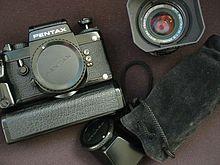Pentax LX

Pentax LX with motor winder, sports finder, and accessories
|
|
| Overview | |
|---|---|
| Maker | Pentax |
| Type | 35 mm single-lens reflex (SLR) |
| Lens | |
| Lens mount | Pentax K |
| Focusing | |
| Focus | Manual |
| Exposure/Metering | |
| Exposure | 1/2000 ~ 4s, bulb (B), aperture priority (Av) |
| Exposure metering | Off-the-film (OTF) TTL |
| Flash | |
| Flash |
Hot shoe, PC socket |
| Shutter | |
| Frame rate | 2 fps with winder, 5 fps with motor drive |
| General | |
| Battery | 2×SR44/LR44, 1×CR11108 |
The Pentax LX is a 35 mm Single-lens reflex camera produced by Pentax in Japan introduced in 1980 and a production run that spanned until 2001. The LX lens mount is known as Pentax K mount which is the proprietary bayonet mount. Also available is an adapter that allow the use of almost all Pentax 35 mm format lenses, those made before 1975 using a screw-mount adapter with no direct functionality to the meter index link, instead, metering is accomplished with the "stop-down" method. It is the top-of-the-line "professional" or "system" camera in the Pentax manual focus range. Compared to contemporary professional bodies from most rival manufacturers, like the Canon F-1 or Nikon F3, the LX body is much smaller and lighter, weighing in at 570 grams (20 ounces) with standard FA-1 finder.
As expected of a professional camera at the time, the LX provides mechanical shutter speeds, ranging from the flash synchronization ('X') speed of 1/75 second to 1/2000 second and bulb ('B'), permitting manual operation without battery power. The slow speeds from 1/60 second to 4 seconds, as well as the exposure meter, are battery dependent. Construction is strong and durable, with a solid cast metal frame and metal covering plates. All buttons and dials are weather and dust sealed, a unique feature not found on other professional cameras of the day. Underneath the satin black finish is black chrome, so that even as the surface finish inevitably wore through in hard professional use, the underlying metal would not look brassy. Both the viewfinder and the focusing screen are interchangeable to suit the task at hand, a large choice of alternatives were available. The camera has a somewhat uncommon frame counter, being able to keep track of the frame number in either direction, whether advancing or rewinding the film; this feature dramatically adds to the flexibility of the camera, as well as aids in multiple exposures. The camera has a multi-function lever that supports mirror lock-up, self-timer and depth of field preview. Both a winder and motor drive were available, and a full complement of other professional accessories. Many additional features could be found inside the camera, the "Magic-Needles" ringed the film take-up spool. Found on M-series bodies, it was included in the LX to make loading a quick task. The shutter curtains are made of a Titanium foil composite and a small thumb operated dial sit to the side of the film plane to operate a mask that could be deployed for use with the time data back when installed in place of the standard back. As stated about the mask for data back, Pentax offered two types. The time stamp version that included a wristwatch style component that was inserted in the back and projected on to the deployed mask. The other data back was a three digit type that could project dates or useful information on to the film. Also taking advantage of the removable back was a high capacity magazine allowing for 250 exposures.
...
Wikipedia
